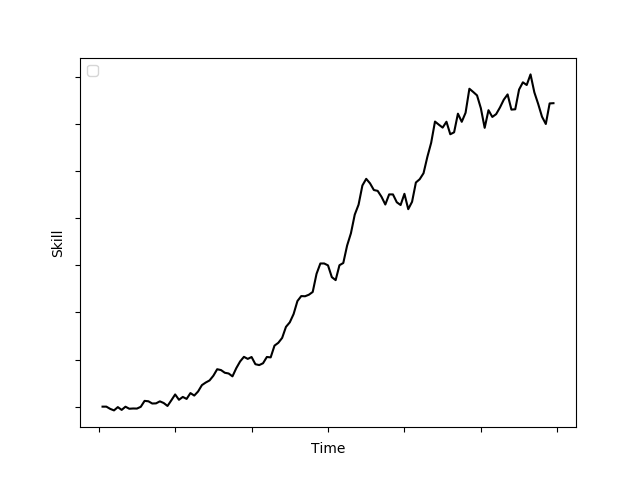Why do we have a poor intuition for processes that unfold non-linearly? How can we leverage compound effects in order to spiral ourselves upwards in terms of health, wealth and knowledge? Let’s explore.
Physical World
Many of our intuitions are rooted in the physical world. When we roll a ball gently across the floor, and it disappears behind a couch we know it will reappear on the other side. It may roll a bit slower and come to a halt eventually. However, we certainly don’t expect that ball to continue to accelerate and shoot through the outer wall, across the yard into the house of an adjacent neighbor.

It’s not that we never expect something to accelerate: if you jump out of a plane you expect to accelerate initially, falling faster and faster. However, that only last for a dozen seconds. After this you reach terminal velocity after which you keep hurtling towards the earth’s surface at a constant speed.
Miracles and Catastrophes
We don’t possess a good intuition for things that keep accelerating, for the simple reason that this does not happen in the physical world in a way we can easily observe or experience directly. When we do observe the outcomes of such accelerated processes, we often refer to its outcome as either a miracle or a catastrophe.
Consider our main building block: a single cell. It divides and after twenty generations of dividing gives rise to a million cells in total. Add to that another twenty generations and there are enough cells to make a human being like yourself. Although this process is, to an extent, scientifically explainable, many label this a miracle when they observe it.
In contrast: we can create nuclear energy by a controlled chain reaction of splitting the nuclei of atoms. When left uncontrolled this can lead to a nuclear explosion, which we label a catastrophe.
In both cases the outcome, a human being or an explosion, is an outcome that we observed and can reason about. Nevertheless, even knowing the facts, the outcome still feels surprising. It does not feel intuitive.
A Rational Example
To explore this a bit further, let’s look at a practical example to test your intuition. Let’s say that I gave you a choice between three options: (a) I give you ten euro’s now, which I guarantee will grow with five percent every day for the next four months, or (b) I give you ten euro’s now and ten euro for every day during the next four months, or (c) instead I give you a thousand euro’s and well: that’s it. Think about it for a moment: what would you do? Read back, reason and pick option a, b or c.
Now that you have picked, let’s take a look at what your best option really was. Starting with the last (c) option, the 1000 euro in your hand, that really is the best choice during a little more than the first three months of the time proposed. However, this is surpassed by the middle option (b) for getting ten euro for every day which tops out after about four months at 1200 euro. Spectacularly, the linear growth of (b) is passed even a couple of days earlier by option (a) with an exponential growth of five percent every day. In fact the first option literally explodes and balloons to nearly 3500 euro after the four months have passed! Was this in line with your expectations?

Interestingly the best option in the end performs quite poorly during the first three months. In fact: quite a bit worse than both other options. It is only after quite some time that the exponential approach starts to really pay off, and when it does: it pays off big time.
Seeing exponential effects plotted this way can help to foster a more intuitive grasp for them, which is much more difficult to infer from only a description. Let’s dive a bit deeper into applied implications of this exponential curve.
Money
The effect of making more money with some money is called compounding. The idea is that you start with some initial amount, called the principal, and then get some interest over this at the end of a time period, when you add that interest back to the principal it is called compound interest, as you can keep repeating this cycle like we did in the graph above.

Whether you know it or not, you are heavily relying on this effect if you take part in any sort of pension scheme, have money in a savings account or are holding onto investments. The idea is that if you have money you can lend it out to others. For this you get compensated: either by interest paid on the loan you provide, or with dividends or increased stock value in case of investments. Either way: you are making money with money.
It is important to realize that the flip side also holds: if you borrow money, you pay interest to whomever is providing you with it. In turn that means you can spend less. Thus, the exponential curve can bend upwards, but it can similarly bend downwards. This also explains the fact that people that have a lot of debt, more easily spiral downwards into a situation with even more debt.
So far we have covered familiar territory, but now I ask you to consider that the same thing that applies to money, also applies to your habits and skills.
The Direction of Habits and Choices
Let’s look at two simple habits. Firstly, brushing your teeth. Spiraling downwards: if you forget to brush your teeth for a day, you’re probably okay. However, if you don’t do it for a year, the exponential effect of bacteria feasting in your mouth, will likely cause significant decay of your teeth. In addition to that direct negative effect, there are others collateral ones too. Just think of the social implications of not brushing your teeth for such a long time. A spiral downwards thus pulls down other things in its wake.

Spiraling upwards: if you read in a book every day, you’re likely to read quite a few books in a year. There is knowledge acquisition even if you remember only a fraction of what you read. Though, the real impact comes after, where if you keep doing this consistently, you can make connections between concepts that you learned previously yielding non-linear gains in knowledge.
Skill Acquisition: A brief diversion into learning
Interpreting a post like this requires the skill of reading. While you probably don’t remember it, reading was incredibly difficult at first. The foundations for this skill were created from the very first time you heard anything. Further growth relied heavily on your environment. You only later learned to link sounds to symbols. Learning to do this consistently and growing a vocabulary large enough to read a text like this took many years. However, currently you are probably not exerting conscious effort to read the letters, or to understand the sentences.
Most adults find learning something new very challenging. One reason for this is that initial progress is usually slow which can be quite discouraging. However, this slow growth is entirely to be expected: like the ten euro’s growing very slowly during the first month in our money example.
Unfortunately, many people simply give up too early, perhaps being thrown off course by their linear expectation of returns. This happens especially for the effort they put in early in the process, where the return on the time spend is still fairly low. After all: when picking up something new you first need to master the basics. Getting through that stage can be though. There is no quick fix for this.
The Shape of Learning
When you are learning something new, you should not expect linear gains for the time you put in. Rather, when you are consistent and stick with it, you will see some large jump in competence every so often. This is somewhat similar to the compound interest effect. Let’s look at an example learning curve.

As I alluded to, learning curves share some similarity with the compound effect, but they are certainly not identical. Learning is not a smooth process that continues forever for a specific skill. Rather, as shown in the example graph above: it is full of plateaus, regression and tapers off at certain point. Beyond this point more and more time needs to be invested to get the skill to a higher level. We can see this if we ignore the details and look at the curve at the distance. This reveals an S-shaped curve. The learning plateaus form smaller S-curves inside a larger S-curve.

Looking at learning through these curves is useful, as they reveal both accelerating and decelerating effects visually. However, they are also limited to specific skills that have a clear path towards mastery. The interplay between different skills and the fluidity in many fields makes their real-world application limited. After all, even if you can identify a letters on a page flawlessly, that does not mean that you can actually understand what you read. And, even if you do understand a text at some level, you may not understand it at all levels the author intended to convey.
After this brief diversion into learning, let’s return to the topic of habits and choices and how we can more practically apply compound effects there.
Choices
We are continuously presented with the challenge of making decisions. The effect of all the small choices we make can lead us to either remain level, spiral upwards or downwards.

Consider three areas: things that you are, things that you have and that you know. In all these areas you can make choices daily, that snowball you in a direction with a positive or negative outcome. An important precondition for this is that you own the outcome itself. After all, outcomes are the result of many small decisions that you yourself made in the past.
These choices really are moment-to-moment things. Do you go to the gym or stay at home? Will you impulsively buy something you see in an ad, or stick to your financial plan and budget? Do you stay at the mediocre job you have or find a better one where you can develop new skills?
What is right for you is what aligns with your personal goals. These goals can be in the areas of physical and mental health, financial and job security, and acquisition of knowledge and skills.
Goals
Once you decide on some area to improve, it is time to make a plan and stick with it. Here is were most people are too ambitious about what they can achieve in the short term. They choose process goals that are hard to keep up. Like going to the gym every day, living in an unusually spartan way, or overloading their brains with information.
Instead it may be better to choose very modest process goals that you can keep up over a long time. Go to the gym twice a week and eat hundred calories less per day, transfer five percent of your income to a savings account automatically, choose one on-line course and spend an evening per week to complete it at most. As we have seen many exponential effects are the result of doing something consistently over a long period of time.
Conclusion
If you start doing something consistently, your progress at first will be slow. However, after some time the effect of whatever you do will start compounding. This process is not intuitive. The outcome will surprise you, even if you understand the concept of compounding rationally.
The effect of compounding is that you will either start to spiral up, or down, in any given area based on the many small choices that you make. Setting modest process goals helps in creating long term consistency which will in turn lead to a noticeable compound effect in your outcomes.
If you are not satisfied with were you are with respect to some specific areas of your life: find places where you can leverage compound effects by making small consistent process changes. Take ownership of the result by setting clear goals and tracking your progress. Then enjoy your outcomes spiral upwards.
References
- Hardy, D. (2010). The Compound Effect.

